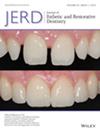3D-printed intracoronal restorations, occlusal and laminate veneers: Clinical relevance, properties, and behavior compared to milled restorations; a systematic review and meta-analysis
Abstract
Objectives
To assess the feasibility of producing 3D-printed intracoronal restorations, thin and ultrathin veneers, and to compare their mechanical behavior, accuracy, biological, and stain susceptibility to the currently applied milled restorations.
Materials and Methods
The databases were comprehensively searched for relevant records up to January 2024 without language restrictions. All studies that assessed 3D-printed partial coverage restorations including inlays, onlays, laminate, and occlusal veneers were retrieved.
Results
The web search yielded a total of 1142 records, with 8 additional records added from websites at a later stage. Only 17 records were ultimately included in the review. The included records compared 3D-printed; alumina-based- and zirconia ceramics, lithium disilicate ceramics, polymer infiltrated ceramics, polyetheretherketone (PEEK), resin composites, and acrylic resins to their CNC milled analogs. The pooled data indicated that it is possible to produce ultrathin restorations with a thickness of less than 0.2 mm. 3D-printed laminate veneers and intracoronal restorations exhibited superior trueness, as well as better marginal and internal fit compared to milled restorations (p < 0.05). However, it should be noted that the choice of materials and preparation design may influence these outcomes. In terms of cost, the initial investment and production expenses associated with 3D printing were significantly lower than those of CNC milling technology. Additionally, 3D printing was also shown to be more time-efficient.
Conclusions
Using additive manufacturing technology to produce restorations with a thickness ranging from 0.1 to 0.2 mm is indeed feasible. The high accuracy of these restorations, contributes to their ability to resist caries progression, surpassing the minimum clinical threshold load of failure by a significant margin and reliable adhesion. However, before 3D-printed resin restorations can be widely adopted for clinical applications, further improvements are needed, particularly in terms of reducing their susceptibility to stains.
Clinical Significance
3D-printed intracoronal restorations and veneers are more time and cost-efficient, more accurate, and could provide a considerable alternative to the currently applied CNC milling. Some limitations still accompany the resin materials, but this could be overcome by further development of the materials and printing technology.

 求助内容:
求助内容: 应助结果提醒方式:
应助结果提醒方式:


